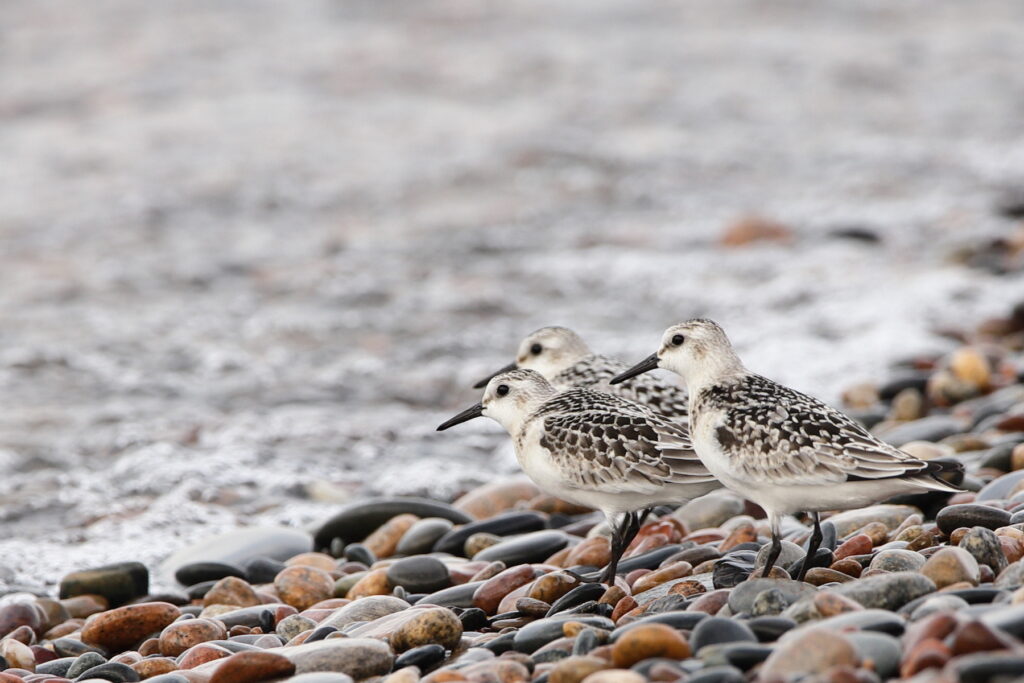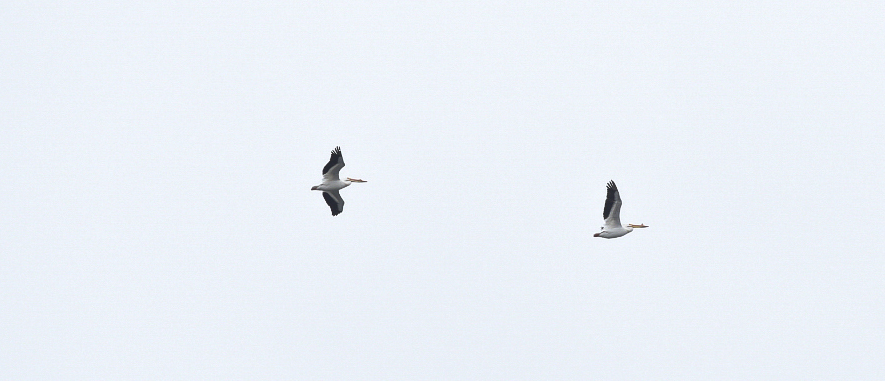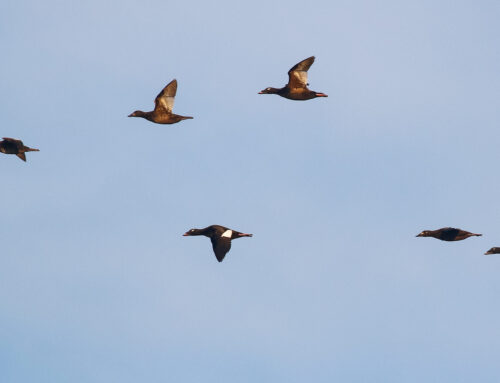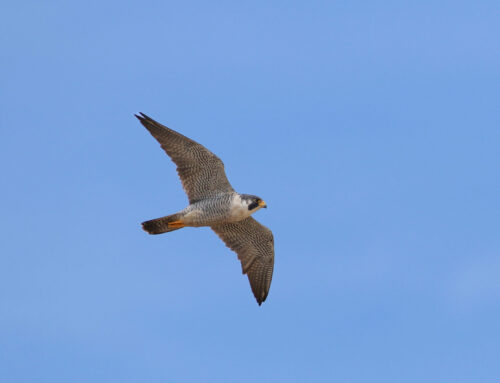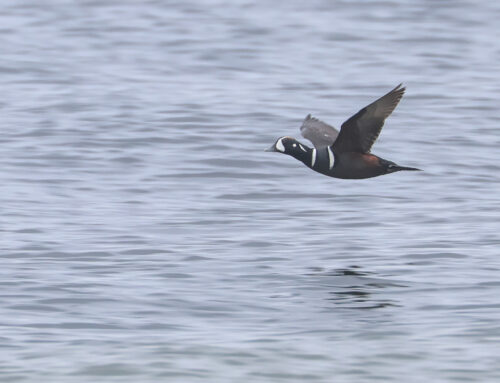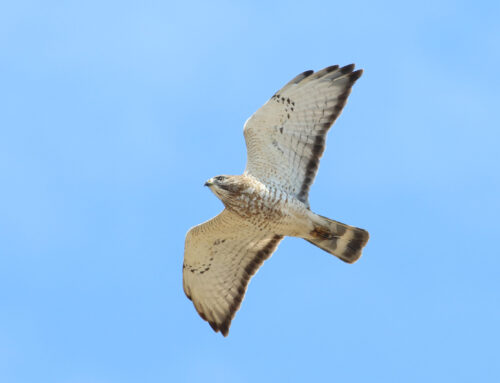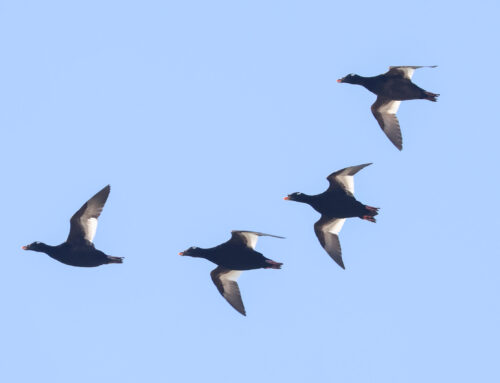Spring migration has this accompanying urgency: many of the shorebirds and waterfowl that pass WPBO’s waterbird count are headed to arctic tundra. Up there, the days are long — but the season is short: the span of days within which to establish a territory and raise up the next generation is acutely finite. Accordingly, migration at WPBO right now goes on around the clock. And both the instinct that buoys these birds north and the urge that compels me to be out there — to witness as much of their journey as I can — runs strong right now.
This week’s most potent waterbird count magic did not come during the standardized 8-hour period that starts at sunrise. During May, this is not a particularly unusual occurrence. In fact, someone asked me the other day what type of hours I kept, and I laughed and said, “bad ones.” It’s true. I get up early, stay out late, and catch more sleep in mid-afternoon (not coincidentally, when birds also are less active!) than I do some nights.
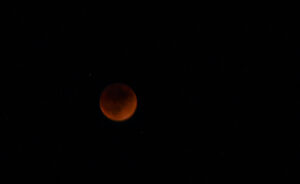
A fairly blurry, handheld shot of the lunar eclipse this past week. But it conveys some of the magic! Photo by Alison Vilag
Earlier this week, I went out to the beach to watch the lunar eclipse. It was dusk; Long-eareds were flying beneath the emerging stars. Blinking lights from wind turbines and cell towers dotted the otherwise dark Canadian and Michigan shorelines, testament to our attachments to energy; to connectivity. I nestled into a piece of driftwood, settling in to observe the moon’s passage into total eclipse and back out again. Night-migrating Long-tailed Ducks were flying north — maybe all the way to Nunavut — yodeling. To Nunavut’s Inuit, the arrival of Long-taileds (in their language, aggiarjuk) heralds spring’s coming. Traditional songs accompany the event — “When we have survived the worst, and the future looks promising, the Long-tailed Ducks have now returned. As they return, they are full of joyous spirit.”
Out there on the beach, my spirit was joyous, too. The very Piping Plover chicks I stewarded two summers ago were courting around me until I left around 1 a.m. I watched the moon through my scope; reflected on the amount of hours I’ve spent on this beach — the ever-deepening connection to place that ensues. At the moment the eclipse entered totality, Common Loons howled up and down the bay. The night pulsed with a connectivity and energy much deeper than the forms produced by wind turbines and cell towers.

A line of White-winged Scoters passes by WPBO’s Waterbird Count. Photo by Alison Vilag
Though sitting through the eclipse will probably be this whole spring’s highlight, the daylight hours of the waterbird count have been rewarding, too! Triple-digit days of White-winged Scoters, Long-tailed Ducks, and Bonaparte’s Gulls continue, and I’ve been consistently getting at least a couple dozen Red-throated Loons most counts. The Black Scoter, the least common spring scoter, has flown by on three occasions this past week.
As is often the case in mid-May, some less-expected species have graced the waterbird count this week. Of these, the rarest was a Smith’s Longspur (per eBird, the first record at Whitefish Point since 2011!). Other highlights included two American White Pelicans and two Marbled Godwits (both May 19), a Northern Mockingbird (May 16), and a Red-headed Woodpecker and Franklin’s Gull on May 14.
Thank you for reading!
~ Alison Világ
2022 Spring Waterbird Counter
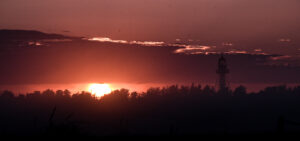
Whitefish Point Lighthouse at sunset. Photo by Alison Vilag
Support WPBO’s Research During Birdathon on May 28
Our skilled team of bird counters and volunteers at Whitefish Point Bird Observatory will set out on a mission to count as many bird species as possible in one day on May 28, 2022, as part of an annual fundraising event supporting the amazing work happening at WPBO! In 2021, a whopping 152 species were counted and the event brought in $6,826.65! Let’s hope this year is just as successful.
This is where you come in! Because our work is 100% donor-funded, Birdathon provides all of our supporters with an opportunity to make a significant impact on our work by making a pledge or direct donation to Birdathon (even after the event). Any amount is helpful, but have some fun with it and consider letting your donation or pledge be inspired by a per-species amount.
Learn more about Birdathon and find links to donate at wpbo.org/birdathon.
Thank you so much to everyone who supports the work being done at WPBO!
